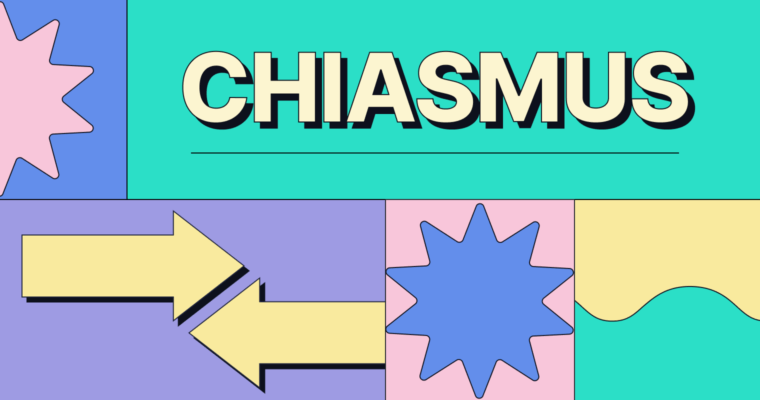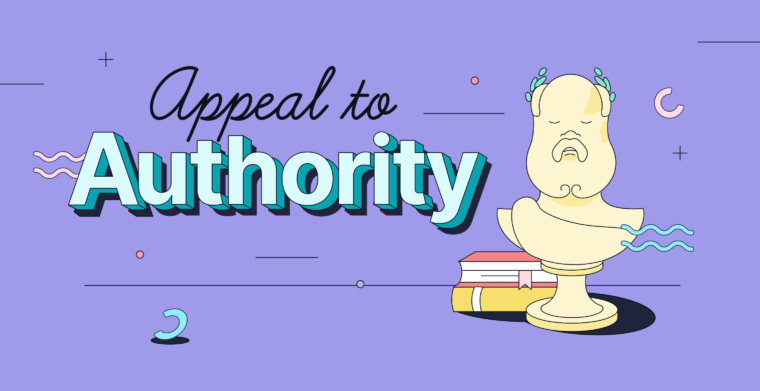
Clear writing is important, but sometimes you want to do more than simply get the message across. To add style to your writing, you can incorporate literary devices like chiasmus. Chiasmus (pronounced kee-az-muss) is a two-part phrase where the second part mirrors the first. It can make your writing more memorable by giving it depth and rhythm.
What is chiasmus?
Chiasmus is defined as a literary device in which words, grammatical constructions, or concepts are repeated in reverse order. It comes from a Greek word meaning “crossing” or “X-shaped.” In practice, chiasmus is when you write a clause and then write a similar clause in reverse.
3 elements of chiasmus
There are three elements to keep in mind when writing chiasmus: parallel words, inverse structure, and relevance to a topic. Let’s break each of those down using the following example:
“Despised, if ugly; if she’s fair, betrayed.” —Mary Leapor, “An Essay on Woman”
1 Parallel words: In the example, despised is parallel to betrayed; both describe what happens to a woman. Ugly is parallel to fair, while both adjectives describe the woman.
2 Inverse structure: The parallel words are not just repeated; they also follow a specific structure that looks like the phrase is being mirrored. If despised and betrayed are the “A” pair, and ugly and fair are the “B” pair, then the structure is A-B-B-A. In other words, despised and betrayed are bookends, and ugly and fair are in the middle.
This is not the case in a phrase like:
She’s not the best, but she’s not the worst.
Even though we have a parallel structure (she and she, best and worst), this is not a chiasmus because its layout is A-B-A-B.
3 Single topic: Both clauses in the example describe the way that women are treated based on their appearance. If the second part of the phrase were to stray from the main topic, it wouldn’t be chiasmus anymore. For example, if Leapor had written, “Women are despised if ugly; if cute, a dog gets a pat,” we would no longer have chiasmus. Even though there is a vaguely parallel structure, the two topics are unrelated.
Chiasmus in writing
Chiasmus is used in writing to deepen an idea or create a memorable rhythm, both of which are useful in persuasive rhetoric.
Deepen an idea
At the core of chiasmus is repetition. You state one thing and then repeat it. If the parallel concepts oppose one another, then chiasmus will deepen their meanings through contrast. If the concepts are similar, then that will create emphasis. For example, consider the line:
“Who dotes, yet doubts; suspects, yet soundly loves!” —Shakespeare, Othello
In this case, both sets of parallel words—dotes and loves, doubts and suspects—have meanings similar to one another. Because of this, the second clause (“suspects, yet soundly loves”) does not provide any new information. Instead, it emphasizes the meaning of the first clause. Would we understand the message if Shakespeare had cut the line in half? Sure, but it would lose some of its artfulness and, therefore, some of its power.
Create rhythm
There are many examples of chiasmus in poetry, in part because the genre often employs a rhythmic use of words. Some find that chiasmus can lend writing a more formal or old-fashioned tone because of the way that it swaps nouns, verbs, and adjectives around to create a mirrored structure.
Imagine chiasmus in conversation:
“They tried hard but lost, the win robbed by their opponent with ease.”
Chiasmus in this casual prose might create vivid imagery, but it also comes off as overdramatic. Think about the tone of your writing when considering chiasmus.
Use in rhetoric
Speechwriting is another place where you are likely to find chiasmus because speeches are intended to be memorable. A famous example of chiasmus in political speech is:
“Ask not what your country can do for you—ask what you can do for your country.” —John F. Kennedy
Now, because the same words—country and country, you and you—are repeated, this is technically an antimetabole (more on that later). But this is an example of the mirror structure that chiasmus also uses to create a memorable statement.
Chiasmus vs. antimetabole
Chiasmus is an inverse structure using parallel words or concepts.
Antimetabole is an inverse structure using the same words.
An example of antimetabole is:
Pleasure’s a sin, and sometimes sin’s a pleasure. —Lord Byron, Don Juan
The parallels in antimetabole are the identical words: pleasure and pleasure, sin and sin. However, they take on the same A-B-B-A structure as chiasmus, which means the two terms are closely related.
There is debate as to whether antimetabole is a subset of chiasmus—a debate we’re not about to settle here. Just know that if you recognize the structure, check out the parallel words. If they are different (but, again, still related!), then it’s chiasmus. If the words are the same, repeated on either side, then it’s antimetabole.
Chiasmus examples
“By day the frolic, and the dance by night.” —Samuel Johnson, The Vanity of Human Wishes
“And these tend inward to me, and I tend outward to them.” —Walt Whitman, Song of Myself
“Adam, first of men, To first of women, Eve” —John Milton, Paradise Lost
Chiasmus FAQs
What is chiasmus?
Chiasmus is a two-part phrase in which the second part mirrors the first in grammatical structures, words, or concepts.
How is chiasmus used in writing?
Chiasmus is used in writing to deepen an idea through contrast or emphasis. It is also often found in poetry and speechwriting because of its memorable repetition.
What are the different elements of chiasmus?
There are three elements to keep in mind when writing chiasmus: parallel words or concepts, an inverse (or mirror) structure, and relevance to a single topic.






